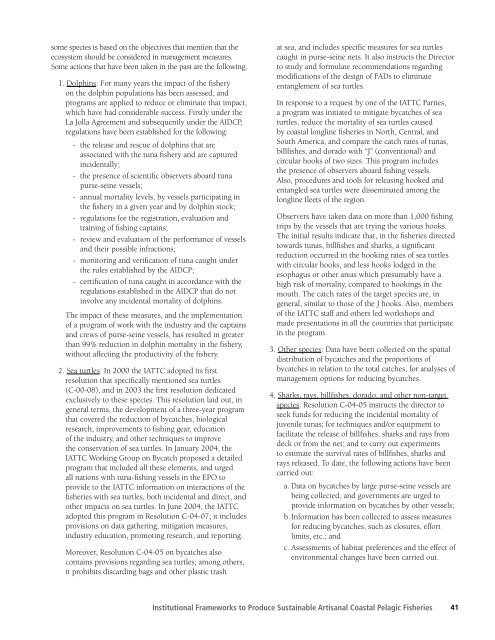PROCEEDINGS OF THE FOuRTH INTERNaTIONal FISHERS FORum
PROCEEDINGS OF THE FOuRTH INTERNaTIONal FISHERS FORum
PROCEEDINGS OF THE FOuRTH INTERNaTIONal FISHERS FORum
Create successful ePaper yourself
Turn your PDF publications into a flip-book with our unique Google optimized e-Paper software.
some species is based on the objectives that mention that the<br />
ecosystem should be considered in management measures.<br />
Some actions that have been taken in the past are the following.<br />
1. Dolphins: For many years the impact of the fishery<br />
on the dolphin populations has been assessed, and<br />
programs are applied to reduce or eliminate that impact,<br />
which have had considerable success. Firstly under the<br />
La Jolla Agreement and subsequently under the AIDCP,<br />
regulations have been established for the following:<br />
- the release and rescue of dolphins that are<br />
associated with the tuna fishery and are captured<br />
incidentally;<br />
- the presence of scientific observers aboard tuna<br />
purse-seine vessels;<br />
- annual mortality levels, by vessels participating in<br />
the fishery in a given year and by dolphin stock;<br />
- regulations for the registration, evaluation and<br />
training of fishing captains;<br />
- review and evaluation of the performance of vessels<br />
and their possible infractions;<br />
- monitoring and verification of tuna caught under<br />
the rules established by the AIDCP;<br />
- certification of tuna caught in accordance with the<br />
regulations established in the AIDCP that do not<br />
involve any incidental mortality of dolphins.<br />
The impact of these measures, and the implementation<br />
of a program of work with the industry and the captains<br />
and crews of purse-seine vessels, has resulted in greater<br />
than 99% reduction in dolphin mortality in the fishery,<br />
without affecting the productivity of the fishery.<br />
2. Sea turtles: In 2000 the IATTC adopted its first<br />
resolution that specifically mentioned sea turtles<br />
(C-00-08), and in 2003 the first resolution dedicated<br />
exclusively to these species. This resolution laid out, in<br />
general terms, the development of a three-year program<br />
that covered the reduction of bycatches, biological<br />
research, improvements to fishing gear, education<br />
of the industry, and other techniques to improve<br />
the conservation of sea turtles. In January 2004, the<br />
IATTC Working Group on Bycatch proposed a detailed<br />
program that included all these elements, and urged<br />
all nations with tuna-fishing vessels in the EPO to<br />
provide to the IATTC information on interactions of the<br />
fisheries with sea turtles, both incidental and direct, and<br />
other impacts on sea turtles. In June 2004, the IATTC<br />
adopted this program in Resolution C-04-07; it includes<br />
provisions on data gathering, mitigation measures,<br />
industry education, promoting research, and reporting.<br />
Moreover, Resolution C-04-05 on bycatches also<br />
contains provisions regarding sea turtles; among others,<br />
it prohibits discarding bags and other plastic trash<br />
at sea, and includes specific measures for sea turtles<br />
caught in purse-seine nets. It also instructs the Director<br />
to study and formulate recommendations regarding<br />
modifications of the design of FADs to eliminate<br />
entanglement of sea turtles.<br />
In response to a request by one of the IATTC Parties,<br />
a program was initiated to mitigate bycatches of sea<br />
turtles, reduce the mortality of sea turtles caused<br />
by coastal longline fisheries in North, Central, and<br />
South America, and compare the catch rates of tunas,<br />
billfishes, and dorado with “J” (conventional) and<br />
circular hooks of two sizes. This program includes<br />
the presence of observers aboard fishing vessels.<br />
Also, procedures and tools for releasing hooked and<br />
entangled sea turtles were disseminated among the<br />
longline fleets of the region.<br />
Observers have taken data on more than 1,000 fishing<br />
trips by the vessels that are trying the various hooks.<br />
The initial results indicate that, in the fisheries directed<br />
towards tunas, billfishes and sharks, a significant<br />
reduction occurred in the hooking rates of sea turtles<br />
with circular hooks, and less hooks lodged in the<br />
esophagus or other areas which presumably have a<br />
high risk of mortality, compared to hookings in the<br />
mouth. The catch rates of the target species are, in<br />
general, similar to those of the J hooks. Also, members<br />
of the IATTC staff and others led workshops and<br />
made presentations in all the countries that participate<br />
in the program.<br />
3. Other species: Data have been collected on the spatial<br />
distribution of bycatches and the proportions of<br />
bycatches in relation to the total catches, for analyses of<br />
management options for reducing bycatches.<br />
4. Sharks, rays, billfishes, dorado, and other non-target<br />
species: Resolution C-04-05 instructs the director to<br />
seek funds for reducing the incidental mortality of<br />
juvenile tunas; for techniques and/or equipment to<br />
facilitate the release of billfishes, sharks and rays from<br />
deck or from the net; and to carry out experiments<br />
to estimate the survival rates of billfishes, sharks and<br />
rays released. To date, the following actions have been<br />
carried out:<br />
a. Data on bycatches by large purse-seine vessels are<br />
being collected, and governments are urged to<br />
provide information on bycatches by other vessels;<br />
b. Information has been collected to assess measures<br />
for reducing bycatches, such as closures, effort<br />
limits, etc.; and<br />
c. Assessments of habitat preferences and the effect of<br />
environmental changes have been carried out.<br />
Institutional Frameworks to Produce Sustainable Artisanal Coastal Pelagic Fisheries<br />
41












